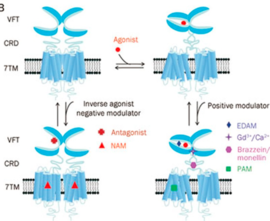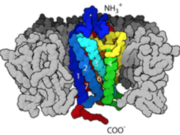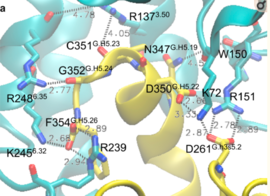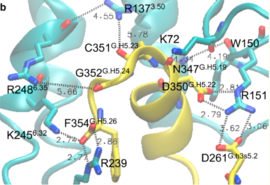NTRODUCTION.
Within the course of our daily activities, we experience several situations that cause us to jump on our feet and also, initiate some kind of response to these situations. Our bodies have an outstanding way of preparing us for such events as to whether flee or fight and it does this by making energy in the form of glucose available in the blood to support our reactions to these events. Our response is effectively mediated through reflex actions which are propagated through networks of neurons that are wired all over our body and eventually to the brain. One of the neurotransmitters produced through the coordination of these neuronal networks is epinephrine. Epinephrine serves as a ligand that bind to a transmembrane protein called GPCR and initiates a sequence of cascading pathways further downstream, that eventually results in the release of glucose into the blood to support the response we carry out.
These ligands bind to a receptor in the Transmembrane called GPCRs. Once the ligand is able to bind tightly to the receptor, the first committed step of the pathway is initiated and the connected pieces begin to join in together until blood glucose level is replenished. More than 800 genes code for GPCRs that regulate several signaling pathways which control blood pressure, behavior, sleep, immune response, cognition…and many other cellular processes.
STRUCTURE HIGHLIGHTS
Structural components of the B2 GPCR.

Disulfide Linkages between the TMD and ECL

Venus fly-trap position of the binding pocket

Amini and Carboxyl terminal groups
G-Protein Coupled Receptors (GPCR), also known as 7 transmembrane receptors [because of its 7 constituent alpha helices] are the largest groups of transmembrane protein receptors in eukaryotes. There are many different classes GPCRs depending on the position of their binding sites or the kind of ligands they bind to. There are about six classes of GPCRs and they include the classes A, B, C, D, E, AND F. Beta adrenergic receptors fall the class C with other metabotropic hormones while Rhodopsin (the light sensing cells in our eye) are categorized under class A. All studied GPCRs have a conserved structure that can be subdivided into; the extracellular domain (ECD), which comprises the three extracellular loops (EC1), (EC2), (EC3) and the N-terminal amino groups, the seven spanning helices transmembrane domain (7TM) embedded within the plasma membrane, and the intracellular domains ICD which also comprises the carboxyl-terminal residues and three intracellular loops (ICL1, ICL2, ICL3). The binding of the receptor to a ligand causes a structural change in the intracellular domains that also signals/activates the alpha subunit of a G-protein to exchange GDP for GTP, transducing the signal further downstream.
For some GPCRs, the ligand binds to a site in the 7TM (certain class A) or both the ECD and the 7TM as in certain class B GPCRs. However, in the Beta Adrenergic receptor, the ligand binds at the the extracellular domain [ECD] which acts like a fly-trap pocket. The transmembrane domain is structurally coupled to the extracellular domain through Disulfide linkages and mutations within this region disrupts the entire structure and function of GPCRs.
The intra cellular domain sits in the cytoplasmic end of the transmembrane domain. This region contains the D/E R Y motif; a conserved region within the ICD that interacts with interacts with intracellular ligands like the G-subunit (activates it) and phosphorylate other kinases as well. The C-terminal domain is structurally independent of the ECD and can adopt functionally discrete conformation in the absence of transmembrane helices. The C-terminal domain regulates the interactions with cytosolic proteins involved in signaling.
FUNCTIONS
GPCRs act as a bridge and communicate the conditions of the cell to the nucleus to induce transcription or affect the processivity of catalytic pathway by activating certain enzymes. In the event of fight/flight, upon binding the ligand epinephrine, it causes a conformational change that leads to the exchange of the Guanine nucleotide (GDP to GTP) and that mechanism "turns" the switch on. The apha subunit then dissociate from the beta and gamma subunits and activates adenylate cyclase which makes cAMP. The cAMP activates Protein Kinase A by binding to its regulatory subunits, and that releases the catalytic subunits to further phosphorylate other proteins in the cell. Eventually, Glycogen phosphorylase is activated which breaks down glucose for use within the cell.
GPCRs control many process which includes the dopaminergic pathway (involved in reward and learning), controls heart rate, vision, metabolism etc.
ENERGETICS
Experimental studies have shown that GPCRs do trigger cellular activities in their unbound states at a minimum basal levels. Studies have also shown that even when bound to agonists, GPCRs express characteristics that range from inactive to a continuum of partially active structures in the absence of the G protein. This means that the presence of the agonist plays an important role in the activation of GPCRs.
The kind and specificity of the agonists determine the activation pathway taken by GPCRs in terms of the energy ordering of the different states which is also premeditated by the respective activation energy landscapes. This means that the agonist-bound inactive state will have the lowest energy state among the various states within the degree of activation.
Activation of the G-protein can be explained by interactions between the GPCR (specifically the ICD) and the G-alpha subunit. During analysis, Molecular Dynamics (MD) simulations found that there is formation of Salt-bridges and Hydrogen bonds between the C-terminal helix of G∝i and some regions in the ICD. Salt-bridges form between D261, D350 of G∝i and K72 of the IC loop 1 and R51 of IC loop 2. There's also formation of Hydrogen bonds between C351 and R137 of the G∝i that replace the inactive state R151-D136-R137-T247 network.Another salt-bridge is formed between the carboxylate group on the G∝i C-terminal residue F354 and K245 of the TM6 and R239 of the IC loop 3. All these structural changes facilitate ligand binding to receptor with high affinity and specificity and leads to an ordered state that further accommodates a more tighter binding to the ligand. The ICD then release the D/E R Y sequence motif from the TMD and this process is coupled to the binding of a ligand that is specific to the coupled domain (G-protein).Full activation occurs when G-proteins bind to the ICD. The stabilizing factor of the activated state of the GPCRs is attributed to the interactions between the Ga (G alpha subunit) and the GPCR.
DISEASE
Many GPCRs have become drug targets of many pharmaceutical drugs because of their central role in controlling many metabolic activities in the cell. Diseases including cancer, diabetes, alzheimer's, sleep deprivation and many others are treated by exploiting the druggability of GPCRs and how they mediate their responses to hormones, cytokines, and neurotransmitters. Of all drugs on the market that have been
approved by the CDC, about 35% elicit their potency and mediate their effects through GPCRs.





